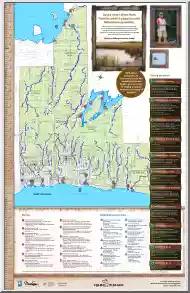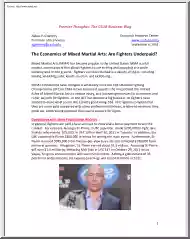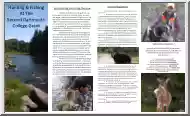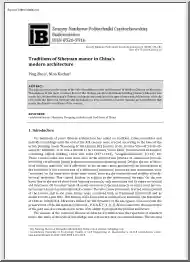Alapadatok
Év, oldalszám:2016, 6 oldal
Nyelv:angol
Letöltések száma:2
Feltöltve:2019. január 17.
Méret:495 KB
Intézmény:
-
Megjegyzés:
Marin County Hang Gliding Association
Csatolmány:-
Letöltés PDF-ben:Kérlek jelentkezz be!
Nincs még értékelés. Legyél Te az első!
Mit olvastak a többiek, ha ezzel végeztek?
Tartalmi kivonat
Source: http://www.doksinet REV 05/16 Mt. Tamalpais Paragliding Rules and Procedures Marin County Hang Gliding Association P.O Box 785 Mill Valley, CA 94942 The Marin County Hang Gliding Association (MCHGA) is designated by the State of California and the County of Marin Departments of Parks and Recreation through special use permits to administer paragliding activities on Mt. Tamalpias Each pilot flying this site is expected to uphold and enforce the flying rules established for the site. Any pilot errors made while flying, such as endangering other pilots, spectators or destruction of government or private property, could result in the revocation of the County or State use permits, with consequent loss of Mt. Tamalpias as a flying site 1. Pilot Qualifications a. All pilots must be current members of the United States Hang Gliding and Paragliding Association. (USHPA) b. Pilots must possess a minimum of a USHPA advanced rating (Para IV) or an USHPA intermediate rating (Para III)
and have received a site introduction and been found competent to fly the site by a MCHGA appointed sponsor. c. Pilots must have a current Mt. Tamalplas sticker attached to the left side of their helmet in order to fly from Mt Tam. The purpose of the helmet sticker is to identify qualified pilots to park authorities and other pilots. Stickers may be obtained in person. To obtain a sticker a pilot must: 1) Present a current USHPA advanced rating membership card, or if an Intermediate pilot (Para III) also present completed Intro/Sign-Off form completed by an authorized sponsor. 2) Complete and sign an application form. 3) Read the Mt. Tamalpias Paragliding Rules and Policies In addition to the helmet sticker, pilots will receive a copy of the rules. Helmet stickers are available from: * The MCHGA Mt Tam Paragliding site director. 1 Source: http://www.doksinet d. All pilots must fly with a reserve parachute. e. Sponsors must be USHPA advanced rated pilots and be approved by the
MCHGA Mt. Tam Paragliding administrator They must be present with the sponsored pilots The sponsor will review the rules for flying Mt. Tam with the intermediate pilots The sponsor will show the intermediate pilot the landing zone. It is the sponsor’s responsibility to judge the conditions and ascertain if it is safe for the sponsored pilot to fly. The site administrator can revoke sponsorship rights for any negligence of the Mt. Tam rules as determined by him, the park authorities or MCHGA officers. This may result in the loss of the sponsor’s own flying privileges on Mt. Tam f. Intermediate (Para III) pilots may fly unsponsored after they have had their introductory sponsored flight(s), been found capable to safely fly the site, and have been issued a Mt. Tam sticker 2. Before Flying Pilots must fill out a registration card (once yearly) and sign in at the Pan Toll Ranger Station (once daily). Maps of the launch and the landing zone will be available at the ranger station. 3.
Launching a. There are three designated take-off sites on Mt. Tam shown on the attached map as #1, #2, and #3. All launches must be made from these sites b. Only one pilot launching and one setting up are permitted on each site. c. There is to be no flying when winds exceed 15 mph at the launch site. d. A pilot familiar with the site must accompany pilots flying the site for the first time. e. Prior to launching pilots shall visually confirm that there is ample space (50’ from beach goers) available for landing. f. When launching pilot shall insure that there are no spectators with in an area encompassing 30’ behind, 50’ in front & 30 degrees to the side of the intended launch course. 4. Flying 2 a. The Restricted Flying Area, indicated on the attached map, must be observed! Do not fly over the town of Stinson Beach. b. There is to be no flying when the beach is not visible from the take off, or when the cloud ceiling is dangerously low. Source:
http://www.doksinet 5. c. There is to be no flying when the landing zone is crowded with people. The State Park Rangers have final authority over flying activities and may close the site if they determine that the beach is too crowded. d. Motorized Paragliding is forbidden. e. Mini-wings are currently prohibited, while their flight and safety characteristics are being studied. f. No glider shall be flown in any manner, which intentionally exceeds its manufacturers maximum recommended limits (wing placard). g. Pilots shall head out to the landing zone with enough altitude to insure at least 100’ clearance when arriving over the beach. Landing Zone a. The landing zone is on the beach at Walla Vista (Marin County Open Space), as indicated on the attached map. All landings must be made in the Designated Landing Zone. When working off excess altitude, work down over the beach or water, not directly over the houses along the beach. b. The first pilot to land in a group should
keep the landing zone clear of spectators for the rest of the group. It is the responsibility of the pilots to avoid the people using the beach. c. Pilots must fold their canopies immediately after landing and clear the landing zone. d. Pilots must walk to their vehicles via the Walla Vista public access. All other roads in the area are private roads and are not to be used. Drivers should park in the area indicated on the attached map. 6. Pilots Responsibilities 3 a. Pilots must comply with all State Park and County Beach regulations governing visitor use (parking, littering, overnight camping, etc.) b. Safety: Pilots are responsible for their own safety and the safety of other pilots and spectators. Each pilot is ultimately responsible for avoiding people in the landing area. c. Judgment: Good judgment is a necessary part of aviation. It requires a thorough knowledge of the limitations of your aircraft, your abilities and the prevailing conditions (such as sufficient
altitude and penetration to cross the houses, etc., Source: http://www.doksinet and whether the landing zone is dangerously crowded). When deciding if you are going to fly, take all things into consideration. d. Self-Regulation: It is each pilots responsibility to uphold and enforce these rules and to cooperate with the Park Rangers. A pilot observing another pilot in violation of these rules is obliged to enforce the rules as follows: 1) Explain to the pilot that he/she is in violation of the rules; request compliance. 2) If unsuccessful in gaining compliance, politely inform the pilot that you are obligated to report him/her to a Park Ranger if the violation continues. 3) Report the pilot to any Park Ranger. Contact the site director and make a verbal report. A pilot violating the rules or witnessing a violation without intervention will: Be issued a citation by the Park Rangers. Be subject to revocation of his/her flying privileges at all sites regulated by BAPA. Risk losing
his/her flying privileges at other USHPA regulated sites. Risk losing his/her USHPA rating. 7. Site Advisories a. In the winter months, high tides can completely cover the landing zone. b. On hot summer days, the landing zone may be extremely crowded. It always looks less, crowded from the mountain than when you arrive over the beach. Its a good idea to check the landing area with binoculars if you have them. c. Post-frontal conditions can be extremely turbulent, especially in the canyons when the prevailing winds are more northerly. d. There are often light winds on the mountain, but there may be strong dense laminar marine winds near the beach. These winds commonly reach 25 kts (29mph), about the top speed of most paragliders. Always check the wind signs on the ocean and lagoon before launching and during flight. e. 4 This site is a long glide to the LZ, especially from launches #1 and #2. Always leave the mountain early allowing plenty of altitude to reach the beach. One
should plan on having at lease 500-ft. left when arriving over the beach in order to allow for errors in judgment & unexpected marine winds. Source: http://www.doksinet f. There can occasionally be northerly winds just above the launch & unexpected gusts blowing over the ridgeline from the north, especially at site #3 even when the apparent winds have been coming steadily up the launch. There is really no defense for this, but checking the winds aloft forecast before going up is a good idea. g. Often the winds on the beach are southerly in the morning while the winds at launch are northwest. During this condition there can be strong sink on the north end of the “mesa”. This sink extends out into “C” canyon and most of the way to the beach. Don’t wander to far north in these conditions or you won’t make the LZ h. Advisories for site #2: This launch works when it is blowing over the back at launch #3, however if the wind will almost always come up at this
launch even if it is strong over the back. If one launches in these conditions he/she will encounter strong turbulence and sink through the canyons and finally a headwind across the mesa. You will not make the LZ in these conditions! It is a good idea to drive to launch #3 first to check out the "true" wind before using this launch. i. Advisories for site #1: This launch is best when the winds are southerly, but is a very long glide to the LZ otherwise. In prefrontal conditions it can be soarable but often the ceiling lowers and the wind gets strong as the front approaches. 8. Emergency Assistance On the mountain, stop any State Ranger vehicle for assistance or contact the Pan Toll Ranger Station at (415)-388-2070. There is a public telephone there also On the beach use the Stinson Beach Fire Department emergency number, (415)-868-1616 PLEASE REMEMBER THAT FLYING MT. TAM IS OUR PRIVILEGE--NOT OUR RIGHT! USE COMMON SENSE AND SOUND JUDGMENT! FLY SAFE! Marin County HANG
GLIDING ASSOCIATION 5 Source: http://www.doksinet
and have received a site introduction and been found competent to fly the site by a MCHGA appointed sponsor. c. Pilots must have a current Mt. Tamalplas sticker attached to the left side of their helmet in order to fly from Mt Tam. The purpose of the helmet sticker is to identify qualified pilots to park authorities and other pilots. Stickers may be obtained in person. To obtain a sticker a pilot must: 1) Present a current USHPA advanced rating membership card, or if an Intermediate pilot (Para III) also present completed Intro/Sign-Off form completed by an authorized sponsor. 2) Complete and sign an application form. 3) Read the Mt. Tamalpias Paragliding Rules and Policies In addition to the helmet sticker, pilots will receive a copy of the rules. Helmet stickers are available from: * The MCHGA Mt Tam Paragliding site director. 1 Source: http://www.doksinet d. All pilots must fly with a reserve parachute. e. Sponsors must be USHPA advanced rated pilots and be approved by the
MCHGA Mt. Tam Paragliding administrator They must be present with the sponsored pilots The sponsor will review the rules for flying Mt. Tam with the intermediate pilots The sponsor will show the intermediate pilot the landing zone. It is the sponsor’s responsibility to judge the conditions and ascertain if it is safe for the sponsored pilot to fly. The site administrator can revoke sponsorship rights for any negligence of the Mt. Tam rules as determined by him, the park authorities or MCHGA officers. This may result in the loss of the sponsor’s own flying privileges on Mt. Tam f. Intermediate (Para III) pilots may fly unsponsored after they have had their introductory sponsored flight(s), been found capable to safely fly the site, and have been issued a Mt. Tam sticker 2. Before Flying Pilots must fill out a registration card (once yearly) and sign in at the Pan Toll Ranger Station (once daily). Maps of the launch and the landing zone will be available at the ranger station. 3.
Launching a. There are three designated take-off sites on Mt. Tam shown on the attached map as #1, #2, and #3. All launches must be made from these sites b. Only one pilot launching and one setting up are permitted on each site. c. There is to be no flying when winds exceed 15 mph at the launch site. d. A pilot familiar with the site must accompany pilots flying the site for the first time. e. Prior to launching pilots shall visually confirm that there is ample space (50’ from beach goers) available for landing. f. When launching pilot shall insure that there are no spectators with in an area encompassing 30’ behind, 50’ in front & 30 degrees to the side of the intended launch course. 4. Flying 2 a. The Restricted Flying Area, indicated on the attached map, must be observed! Do not fly over the town of Stinson Beach. b. There is to be no flying when the beach is not visible from the take off, or when the cloud ceiling is dangerously low. Source:
http://www.doksinet 5. c. There is to be no flying when the landing zone is crowded with people. The State Park Rangers have final authority over flying activities and may close the site if they determine that the beach is too crowded. d. Motorized Paragliding is forbidden. e. Mini-wings are currently prohibited, while their flight and safety characteristics are being studied. f. No glider shall be flown in any manner, which intentionally exceeds its manufacturers maximum recommended limits (wing placard). g. Pilots shall head out to the landing zone with enough altitude to insure at least 100’ clearance when arriving over the beach. Landing Zone a. The landing zone is on the beach at Walla Vista (Marin County Open Space), as indicated on the attached map. All landings must be made in the Designated Landing Zone. When working off excess altitude, work down over the beach or water, not directly over the houses along the beach. b. The first pilot to land in a group should
keep the landing zone clear of spectators for the rest of the group. It is the responsibility of the pilots to avoid the people using the beach. c. Pilots must fold their canopies immediately after landing and clear the landing zone. d. Pilots must walk to their vehicles via the Walla Vista public access. All other roads in the area are private roads and are not to be used. Drivers should park in the area indicated on the attached map. 6. Pilots Responsibilities 3 a. Pilots must comply with all State Park and County Beach regulations governing visitor use (parking, littering, overnight camping, etc.) b. Safety: Pilots are responsible for their own safety and the safety of other pilots and spectators. Each pilot is ultimately responsible for avoiding people in the landing area. c. Judgment: Good judgment is a necessary part of aviation. It requires a thorough knowledge of the limitations of your aircraft, your abilities and the prevailing conditions (such as sufficient
altitude and penetration to cross the houses, etc., Source: http://www.doksinet and whether the landing zone is dangerously crowded). When deciding if you are going to fly, take all things into consideration. d. Self-Regulation: It is each pilots responsibility to uphold and enforce these rules and to cooperate with the Park Rangers. A pilot observing another pilot in violation of these rules is obliged to enforce the rules as follows: 1) Explain to the pilot that he/she is in violation of the rules; request compliance. 2) If unsuccessful in gaining compliance, politely inform the pilot that you are obligated to report him/her to a Park Ranger if the violation continues. 3) Report the pilot to any Park Ranger. Contact the site director and make a verbal report. A pilot violating the rules or witnessing a violation without intervention will: Be issued a citation by the Park Rangers. Be subject to revocation of his/her flying privileges at all sites regulated by BAPA. Risk losing
his/her flying privileges at other USHPA regulated sites. Risk losing his/her USHPA rating. 7. Site Advisories a. In the winter months, high tides can completely cover the landing zone. b. On hot summer days, the landing zone may be extremely crowded. It always looks less, crowded from the mountain than when you arrive over the beach. Its a good idea to check the landing area with binoculars if you have them. c. Post-frontal conditions can be extremely turbulent, especially in the canyons when the prevailing winds are more northerly. d. There are often light winds on the mountain, but there may be strong dense laminar marine winds near the beach. These winds commonly reach 25 kts (29mph), about the top speed of most paragliders. Always check the wind signs on the ocean and lagoon before launching and during flight. e. 4 This site is a long glide to the LZ, especially from launches #1 and #2. Always leave the mountain early allowing plenty of altitude to reach the beach. One
should plan on having at lease 500-ft. left when arriving over the beach in order to allow for errors in judgment & unexpected marine winds. Source: http://www.doksinet f. There can occasionally be northerly winds just above the launch & unexpected gusts blowing over the ridgeline from the north, especially at site #3 even when the apparent winds have been coming steadily up the launch. There is really no defense for this, but checking the winds aloft forecast before going up is a good idea. g. Often the winds on the beach are southerly in the morning while the winds at launch are northwest. During this condition there can be strong sink on the north end of the “mesa”. This sink extends out into “C” canyon and most of the way to the beach. Don’t wander to far north in these conditions or you won’t make the LZ h. Advisories for site #2: This launch works when it is blowing over the back at launch #3, however if the wind will almost always come up at this
launch even if it is strong over the back. If one launches in these conditions he/she will encounter strong turbulence and sink through the canyons and finally a headwind across the mesa. You will not make the LZ in these conditions! It is a good idea to drive to launch #3 first to check out the "true" wind before using this launch. i. Advisories for site #1: This launch is best when the winds are southerly, but is a very long glide to the LZ otherwise. In prefrontal conditions it can be soarable but often the ceiling lowers and the wind gets strong as the front approaches. 8. Emergency Assistance On the mountain, stop any State Ranger vehicle for assistance or contact the Pan Toll Ranger Station at (415)-388-2070. There is a public telephone there also On the beach use the Stinson Beach Fire Department emergency number, (415)-868-1616 PLEASE REMEMBER THAT FLYING MT. TAM IS OUR PRIVILEGE--NOT OUR RIGHT! USE COMMON SENSE AND SOUND JUDGMENT! FLY SAFE! Marin County HANG
GLIDING ASSOCIATION 5 Source: http://www.doksinet



